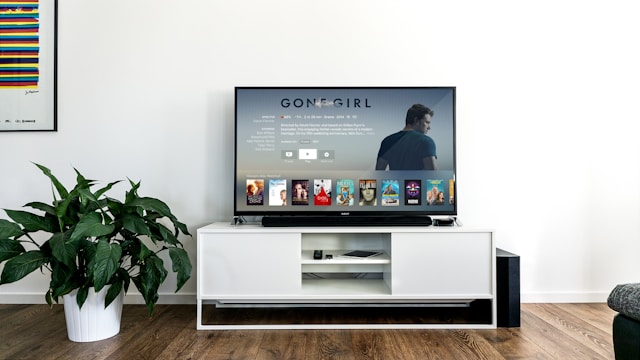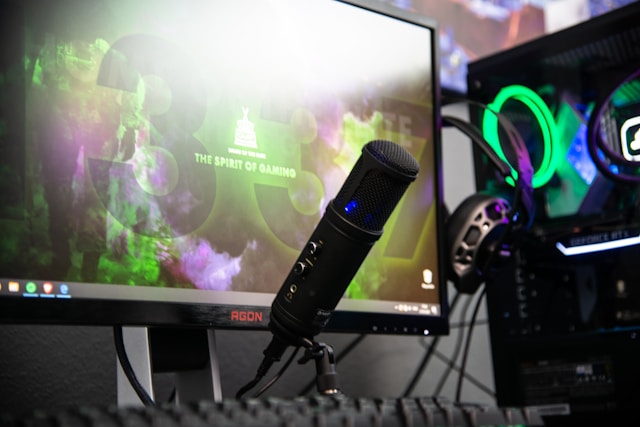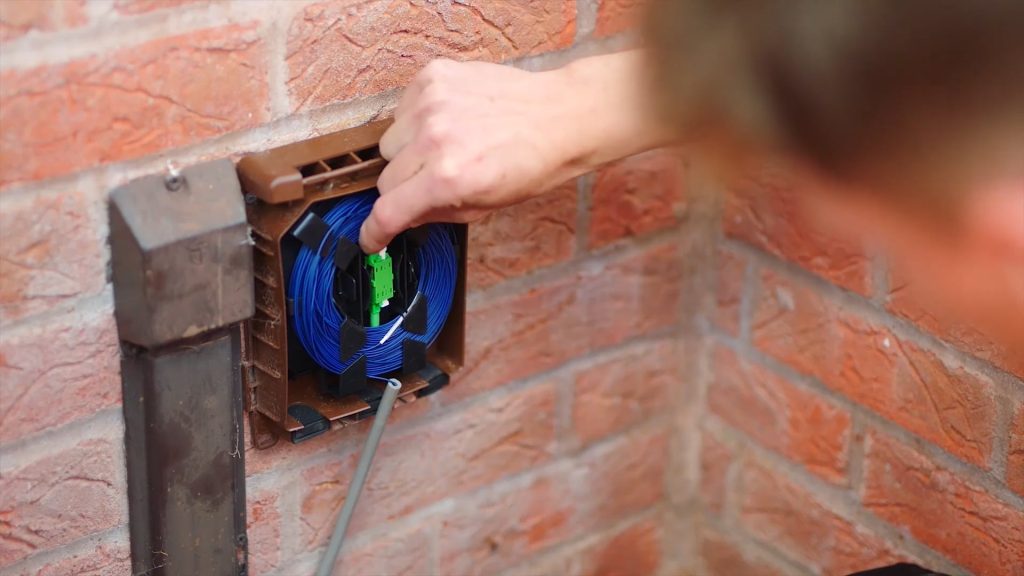Full Fibre Broadband, or Fibre to the Premises (FTTP), uses fibre-optic cables to connect to the cabinet in the street directly to your property for a reliable and fast connection.
What is Full Fibre Broadband?
Full Fibre Broadband connects fibre-optic cables from the exchange to your home. Unlike traditional copper cables that run from the street cabinet to your property, data transmission is fast and uninterrupted. The resilient and cutting-edge fibre-optic cables can withstand weather conditions like rain and snow and can deliver gigabit speeds no matter how many people are connected and using the internet.

The Technology Behind Full Fibre
Fibre-optic cables comprise optical fibres, thin, hair-like glass strands bundled together. This core is wrapped in another glass layer called cladding. When using fibre-optic cables for internet connection, the transmitted data converts from electrical signals to light pulses. When the light travels through the cable, it constantly bounces from the cladding in a phenomenon called total internal reflection, allowing the light to travel long distances without losing much signal. The light is then converted back into electrical signals so you can use it to enjoy gigabit speed full fibre broadband.
Evolution from Copper to Fibre
Copper has long been the dominant medium for transmitting data thanks to its excellent conductivity, high flexibility, and thermal-resistant properties. However, copper cables have limited bandwidth, are subject to signal interference, and perform poorly when transmitting data over long distances due to signal degradation. These problems make copper wires unsustainable in a highly digital society.
You won’t need to worry about low bandwidth and compromised speeds with fibre-optic cables. This technology offers significantly higher bandwidth and faster speeds with no threat of interference. The low latency enables quicker response times for real-time data transmission, preventing signal delays that are more common with copper cables. The evolution of copper to fibre-optic cables is inevitable, especially as the world becomes more reliant on digital solutions. With its significant advantages over copper, a fibre-optic system is the most future-proof broadband technology.
How Full Fibre differs from normal broadband
Many broadband connections utilise copper wires, either fully or partially. Copper broadband uses copper wires to connect from an exchange to a street cabinet and then to the home. FTTC, or Fibre to the Cabinet, broadband uses both fibre-optic cables and traditional copper wires, which increases speed and performance compared to full copper broadband. However, using copper wires hinders its performance, speed, and reliability, especially during busier periods. Full Fibre Broadband uses fibre-optic cables from the exchange to the home, enabling ultrafast speeds and the best reliability, even during peak usage times.
Full Fibre vs Fibre Broadband (FTTP vs FTTC)
While Full Fibre Broadband and traditional broadband options like FTTC (Fibre to the Cabinet) both use fibre-optic cables, the two have significant differences. FTTC broadband uses a fibre-optic cable to connect the exchange with the street cabinet, but old-fashioned copper wires run from the cabinet to your home. The pure fibre approach of FTTP broadband eliminates the need for copper wires, as fibre-optic cables go all the way from the exchange to your home or business.
Speed and Performance
Use of copper cables inhibits the hybrid model of FTTC, as they can affect speeds and the strength of the signal, especially if you live farther from the cabinet. Copper is also often shared between multiple homes or businesses, slowing the connection even further. Speeds range around 40 Mbps to 80 Mbps, but this may vary depending on how far you are from the cabinet, how many devices are using the connection, and the bandwidth requirements of your activities. Download and upload speeds are also asymmetrical, with the latter being much slower. However, copper is easily affected by weather conditions or signal interferences, impacting the speeds and performance of your connection.
The fibre-optic cables of FTTP broadband aren’t held back by the issues of copper cables. You can enjoy lightning-fast speeds of 100 Mbps to 2 Gbps. You can also find packages on Zzoomm that offer symmetrical speeds, meaning download and upload speeds are equally fast. These connections can be great if you’re streaming to your fans, or uploading a lot of media or large files for work or a hobby. Fibre-optical cables are also incredibly weather-resistant and don’t face signal interferences, so rain or shine, you can enjoy a stable connection. Even if multiple devices are connected and being used for various purposes, the speed of Full Fibre Broadband isn’t compromised. You can stream, play games, download files, and more without being affected by others’ activities.
Is Full Fibre Broadband available in your area?
The rollout of Full Fibre Broadband in the UK is in full force, and more and more areas now offer FTTP connection for millions of premises. You can explore a wide variety of plans from Zzoomm with different speeds and prices that suit the specific needs of your home or business, from 150 Mbps Full Fibre to 2 Gbps Full Fibre. Zzoomm’s FTTP network is built on 10 Gbps broadband technology, so you can enjoy gigabit service speeds.
Checking availability
You can utilise an online availability checker to check if FTTP is available in your area. Zzoomm’s availability checker can provide a straightforward experience to get you the necessary information. Choose a product line, whether you plan to connect your residence, business, or enterprise to a Full Fibre connection, and enter your postcode. The checker will show you whether you can upgrade to an FTTP connection for high-speed internet. If Full Fibre Broadband isn’t yet available in your area, you can still find other high-speed options and stay updated on potential rollouts. While it’s not as fast as FTTP, FTTC can still offer a significant speed boost from traditional copper broadband. You can also use online comparison tools and ISP websites to check availability in your area. To stay in the loop on future FTTP expansions, you can subscribe to the newsletters or social media accounts of ISPs or government and local institutions overseeing the rollout of FTTP.
The benefits of Full Fibre Broadband

Gaming
Whether you’re enjoying a casual online gaming session, in multiplayer mode with friends, or gaming competitively, a speedy and reliable connection can keep you locked in. Games have become more advanced, boasting increased complexity and high-quality graphics on both console and PC. Full Fibre can help you get the most immersive experience out of your fantasy RPGs or first-person shooter games with higher bandwidth and low latency. This is especially helpful with multiplayer games that transmit vast amounts of data, enabling you to keep up with teammates and increasing your chances of getting the win. High-speed internet is also a must for competitive esports, as even a short moment of lag can cost you the win.

Working from home
More and more people have embraced a hybrid or remote work setup in recent years, emphasising the need for a fast and seamless internet connection in the home to prevent work interruptions. With an unreliable broadband connection, you may experience glitchy or laggy video conferencing, slow download and upload speeds, and subpar performance of your VPN. If you work from home with FTTP broadband, you can complete your tasks and send or access files without interruptions. For instance, downloading a 2 GB file for work on an FTTC broadband connection, which can reach up to 80 Mbps, will take around three minutes. Ultrafast Full Fibre with gigabit speeds can do the job in about 16 seconds. You also won’t have to worry about frozen visuals or choppy audio during virtual meetings, ensuring you can receive and give important work information without hitches. Fibre-optic cables are also much more challenging to intercept than copper cables, enhancing security so you can share and work on confidential documents without fear of being compromised.

Entertainment
Watching a movie or TV series on streaming services, scrolling through social media, and leveraging innovations like smart home assistants or virtual reality headsets will require a strong and speedy connection to run and perform smoothly. With a typical FTTC connection, you may experience slower download speeds, longer loading times, and connection disruptions due to bad weather. Leave buffering and lag behind with a Full Fibre connection, which has the bandwidth to handle real-time data transmission and download large files within seconds.

Streaming
When you’re live streaming on platforms like Twitch or YouTube, few things are more infuriating than constant buffering and lagging. Full Fibre Broadband, with its ultrafast speeds, reliability, and resilience, ensures you won’t miss a second of your live broadcast. With no signal delays or interferences, real-time data transmission is smooth and disruption-free. Even when streaming high-definition or 4K content, the gigabit speeds ensure your stream loads and plays seamlessly. If multiple devices are accessing the internet simultaneously, the bandwidth offered by Full Fibre prevents any lag or slowdown. You can be live streaming your gameplay on Twitch while a housemate watches a gaming stream on YouTube, and neither of you will struggle with buffering or low resolution.

FAQs
Q: What is full fibre broadband?
A: Full Fibre Broadband, or Fibre to the Premises (FTTP), uses a pure fibre approach with fibre-optic cables connecting directly from the street cabinet to your property, enabling reliable and high-speed internet.
Q: How does full fibre broadband differ from FTTC?
A: Full Fibre Broadband uses fibre-optic cables all the way from the exchange to your property. FTTC broadband uses a hybrid system with fibre-optic cables running from the exchange to the street cabinet and copper cables from the cabinet to your home or business. Thanks to resilient fibre-optic cables, Full Fibre is much faster and more reliable.
Q: Is full fibre available in my area?
A: You can use availability checker tools online to see if you can get FTTP installed for your home or business.
Q: What are the benefits of full fibre broadband for gaming?
A: Full Fibre Broadband delivers super-fast speeds, enabling lag-free gameplay and quick downloads. With low latency and ping, your commands register instantly. The stable, reliable connection ensures smooth gaming sessions without interruptions, even when others in your house are online.
Q: How does full fibre improve streaming quality?
A: The swift speeds of FTTP broadband enable videos and live streams to load and play instantly. The high bandwidth and efficiency of real-time data transmission allow for high-resolution streams like 4K for an immersive experience.
Q: Can full fibre support multiple devices simultaneously?
A: Even with multiple devices streaming, speed and bandwidth aren’t compromised. With Full Fibre Broadband, you and your housemates can enjoy smooth streaming, high-quality visuals, and no loading times.
Q: What speeds can I expect with full fibre broadband?
A: Full Fibre Broadband speeds can range from 100 Mbps to 2 Gpbs or even higher.
Q: How do I switch to Full Fibre Broadband?
A: If you’ve confirmed that Full Fibre Broadband is available in your area, you can browse through FTTP packages to find one that fits your needs and budget. Zzoomm offers plans ranging from 150 Mbps Full Fibre to 2 Gbps Full Fibre. Once you’ve chosen your plan, you can schedule installation and enjoy high-speed internet.
Q: Is full fibre more expensive than traditional broadband?
A: Full Fibre Broadband can be more expensive than traditional broadband connections and FTTC, but at Zzoomm we offer competitive packages, cheaper than far slower connections offered by the traditional broadband providers.
